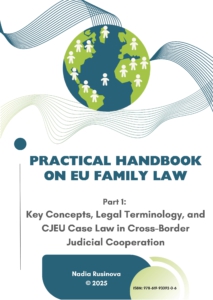Views
Charuvila Philippose v. P.V. Sivadasan: Harmonizing India’s Civil Procedure Code and the Hague Service Convention
Written by George Jacob, Incoming Associate, Bombay Law Chambers
Globalisation has led to a rise in cross-border disputes, making international service of summons increasingly relevant. While domestic service in India is straightforward, sending summons to foreign defendants involves complex legal procedures. Proper service ensures that the defendant is duly notified and can respond, embodying the principle of audi alteram partem. Until recently, the procedure for international service in India was unclear. This ambiguity was addressed by the Kerala High Court in Charuvila Philippose v. P.V. Sivadasan.[1] This blog outlines the legal frameworks for international service, revisits the earlier Mollykutty[2] decision, and analyses the broader implications of Charuvila Philippose. Read more
Foreign Judgments and Indirect Jurisdiction in Dubai (UAE): One Step Forward, One Step Back?

I. Introduction:
In 2024, the Dubai Supreme Court rendered a significant decision on the issue of indirect jurisdiction under UAE law. Commenting on that decision (see here), I noted that it offered “a welcome, and a much-awaited clarification regarding what can be considered one of the most controversial requirements in the UAE enforcement system” (italic in the original).
The decision commented on here touches on the same issue. Yet rather than confirming the direction suggested in the above-mentioned decision, the Court regrettably reverted to its prior, more restrictive approach. This shift raises doubts about whether a consistent jurisprudence on indirect jurisdiction is taking shape, or whether the legal framework remains fragmented and unpredictable.
Enforceability Denied! When the SICC’s Authority Stopped at India’s Gate
Written by Tarasha Gupta, BALLB (Hons), Jindal Global Law School, and Saloni Khanderia, Professor, Jindal Global Law School (India)
The Singapore International Commercial Court (“SICC”) has become a preferred hub for hearing litigation and arbitration of international commercial disputes. Accordingly, many decisions from the SICC require recognition and enforcement in India.
In this light, a recent judgment from the Delhi High Court (“HC”) is a significant development providing relief to those wishing to enforce the SICC’s judgments in India. In Discovery Drilling Pte Ltd v. Parmod Kumar & Anr,[1] the HC has held that the SICC is a superior court under Section 44A of the Code of Civil Procedure, 1908 (“CPC”). As a result, its judgments can be directly executed in India. That said, the HC ultimately held the judgment in question to be unenforceable, as it failed to meet the tests in Section 13 of the CPC.
This article breaks down the arguments and legal context behind the HC’s judgment. It also highlights how the case demonstrates flaws in India’s regime, which create difficulties not just for creditors trying to enforce foreign judgments in India, but also in enforcing India’s judgments abroad. Read more
News
Praxis des Internationalen Privat- und Verfahrensrechts (IPRax) 5/2025: Abstracts
The latest issue of the „Praxis des Internationalen Privat- und Verfahrensrechts“ (IPRax) features the following articles:
Call for papers: 2025 NGPIL Conflict of Laws’ Essay Prize
Originally posted on NGPIL blog on 26 August 2025
The Nigeria Group on Private International Law invites submissions for the annual NGPIL Conflict of Laws’ Competition. The winner will be awarded for the best essay on any aspect of Nigerian conflict of laws. Entries will be accepted from the following: an undergraduate and/or postgraduate scholar studying in Nigeria, or any Nigerian lawyer five years call or below practising and residing in Nigeria. The essay should be unpublished at the time of submission. Submitted essays should be in the English language. Submitted essays should also be within five to eight thousand words. Competitors may be citizens of any nation, age or gender but must be an undergraduate and/or postgraduate scholar studying in Nigeria, or any lawyer below five years post-call experience practising and residing in Nigeria.
The first prize is 200,000 Naira (NGN), and the winner of the competition will be encouraged to publish the paper in any high-quality peer reviewed journal on private international law (conflict of laws). The second prize is 120,000 Naira (NGN), and third prize is 80,000 Naira (NGN). The prize is sponsored by and will be awarded by NGPIL.
Submissions to the Prize Committee must be received no later than 31 October 2025. Entries should be submitted by email in Word or pdf format. The winner will be announced no later than 2 months after the deadline. Decisions of the NGPIL on the winning essay and on any conditions relating to this prize are final. Submissions and any queries should be addressed by email to ngpilaw@gmail.com. All submissions will be acknowledged by e-mail.
Previous Winners
Peace George (Winner for the 2023/2024 session)
Oluwabusola Fagbemi (Winner for the 2022/2023 session)
Solomon Adegboyo (Winner for the 2021/2022 session)
Clarity in Complexity: Nadia Rusinova’s Practical Handbook on EU Family Law, Part I
 Family law in the European Union is an intricate, fast-evolving, and politically sensitive area of judicial cooperation. With issues ranging from cross-border divorce to international child abduction, and from parental responsibility to maintenance obligations, practitioners and judges must constantly navigate overlapping instruments, shifting jurisdictional rules, and complex interactions between national and EU law.
Family law in the European Union is an intricate, fast-evolving, and politically sensitive area of judicial cooperation. With issues ranging from cross-border divorce to international child abduction, and from parental responsibility to maintenance obligations, practitioners and judges must constantly navigate overlapping instruments, shifting jurisdictional rules, and complex interactions between national and EU law.
The Practical Handbook on EU Family Law: Part I – Key Concepts, Legal Terminology, and CJEU Case Law in Cross-Border Judicial Cooperation, authored by Nadia Rusinova and freely available online for download, positions itself as a much-needed companion in this field. Drawing on the Court of Justice of the European Union’s jurisprudence and the architecture of EU family law, the handbook provides a clear roadmap through legal terminology, concepts, and cross-instrument mechanisms.
Structure and Foundations
The opening Unit 1 sets the stage by outlining the purpose, audience, and method of the handbook. It presents itself as a practical tool designed to support judges, lawyers, academics, and students in navigating the complexities of cross-border family cases. Particularly noteworthy is the emphasis on English as a tool of legal harmonization, highlighting its role as a neutral bridge across diverse national legal systems and a means of fostering greater coherence in judicial cooperation.
EU Family Law in Context
Unit 2 provides the legal and institutional backdrop. It introduces the competence of the EU under Article 81 TFEU, the limits imposed by the special legislative procedure, and the use of enhanced cooperation (e.g., in matrimonial property regimes). It also offers a historical overview, tracing family law’s evolution within the broader framework of judicial cooperation in civil matters. The treatment of the Brussels II system is especially helpful in showing how successive instruments have created the backbone of today’s EU family law. For readers less familiar with EU competences, the discussion of direct applicability, primacy, and the role of domestic courts situates family law firmly within the EU’s constitutional order.
Cross-Instrument Legal Concepts
The third unit is a central part of the handbook, bringing together core legal concepts that recur across family law instruments. These include:
- Structural terms: “civil matters”, “court”, “habitual residence”, “central authorities”.
- Applicable law concepts: universal application, renvoi, and party autonomy.
- Safeguards: public policy and the best interests of the child.
- Jurisdictional coordination: lis pendens, related actions, prorogation, residual jurisdiction.
- Recognition and enforcement: the circulation of decisions, exequatur, enforcement measures, and grounds for refusal.
This cross-instrument perspective demonstrates how family law rules form part of a system of judicial cooperation, requiring coherent interpretation across instruments. The integration of CJEU case law grounds the discussion in practice.
Matrimonial Matters
Unit 4 turns to marriage-related proceedings: divorce, legal separation, annulment, and the recognition of non-judicial divorces involving public authorities. The coverage of jurisdictional bases (such as the habitual residence of spouses and counterclaims) and the recognition of decisions highlights the challenges courts face when marriages break down across borders.
Parental Responsibility
One of the most sensitive aspects of family law, Unit 5 addresses custody, access rights, and parental responsibility. Concepts such as continuing jurisdiction, transfer of jurisdiction, and urgent measures are explained with clarity. The section on perpetuatio fori, which ensures stability of jurisdiction once proceedings are initiated, is particularly insightful. The discussion of enforcement balances the importance of privileged decisions (such as those automatically enforceable) with the role of coercive and non-coercive measures in practice.
International Child Abduction
Unit 6 provides a well-structured synthesis of the 1980 Hague Convention and the EU’s overriding mechanism. It covers wrongful removal or retention, return procedures, and exceptions such as grave risk of harm or settlement of the child. The attention to post-decision scenario, such as further abduction or non-compliance, demonstrates the handbook’s practical orientation and awareness of the complexities courts encounter in real-world cases.
Maintenance Obligations
Unit 7 completes the thematic coverage with maintenance obligations. It clarifies terminology (creditor, debtor, subrogation of public bodies) and explains jurisdictional bases, including forum necessitatis, which safeguards access to justice where no other court is available. The treatment of applicable law and the recognition and enforcement of maintenance decisions is highly useful for practitioners managing the financial dimensions of cross-border disputes.
Annexes and Added Value
The annexes provide a set of especially useful practical tools:
- An alphabetical glossary of terms for quick reference.
- Tables and figures that map out jurisdictional rules and procedures.
- CJEU case law indexed by legal term.
In Conclusion
With this work, Nadia Rusinova has produced a handbook that renders EU family law accessible, well-structured, and firmly practice-oriented, while at the same time combining doctrinal depth with methodological precision. This dual quality enables the handbook to serve not only as a reliable guide for practitioners confronted with cross-border family law issues, but also as a valuable scholarly contribution to the academic study of EU judicial cooperation. Its layered design – beginning with foundational principles, moving through cross-cutting concepts, and then addressing specific domains – makes the handbook equally indispensable for lawyers, judges, and academics alike.
Congratulations, Nadia!


